The OnePlus One Review
by Joshua Ho on November 19, 2014 8:00 AM EST- Posted in
- Smartphones
- Android
- Mobile
- OnePlus
Camera UX
For the most part, the OnePlus One has a generally standard camera system for 2014 smartphones. With a 6P lens system, F/2.0 aperture, and Sony IMX214 camera sensor, the OnePlus One has a relatively standard camera system for today's smartphones. The focal length is similar to most smartphones on the market at a relatively wide 3.8mm length, which makes it equivalent to a 28mm focal length when accounting for the crop factor of the sensor. The front facing camera has an OmniVision OV5648 sensor, which is a 5MP, 1.4 micron, 1/4 inch sensor, with an F/2.0 aperture at 2.67mm focal length. This means that the field of view is similar to the rear-facing camera at about 29mm accounting for the crop factor.
While the camera hardware is relatively standard, the camera interface is definitely a unique take, and is the first time that I've been able to use Cyanogen's camera UI. In general, this UI feels like a mix of the old Google Camera, along with an immense amount of complication and not much explanation. For example, in the settings there's an ISO selection menu. While this is nothing to talk about normally, there's a setting called "Auto (HJR)". The only way for me to learn about this setting is by searching for it on Google, which explains that it favors higher ISOs to reduce the effects of shaky hands. As of the latest 44S update, this crashes the camera any time I try to take a photo in low light. To further explain the point, there are plenty of options in the video size setting, but a huge number of them are completely unexplained. While one might easily guess what 4K UHD or HD 1080p is, I find it difficult to believe that 4k DCI, CIF, or QCIF are self-explanatory. Interestingly enough, turning RAW capture on or off also has an effect on the maximum shutter speed, something that isn't actually detailed anywhere.
While an unfamiliar UI is not really a massive issue, there are some fundamental flaws with how the UI works. One of the most obvious flaws is the aspect ratio of the preview, which is 16:9, when output images can have a 4:3 aspect ratio. This makes it impossible to accurately frame an image. In order to do the ISO chart test, it was necessary to use Google Camera to frame the chart before switching back to the Cyanogen camera.
In addition to all of this, the scene selection UI doesn't have much thought put into it. All filters and all scene modes are integrated into a single menu, which is navigated by swiping up and down on the preview. This wouldn't really be an issue but when there are 31 options to swipe through this really gets to be a bit much to handle. There is a list option that can be found by going through the menus though, which is a bit better at organizing information. Unfortunately, most of the scene options are a bit nonsensical. The "night" modes don't actually change anything (ISO and shutter speed seem to be identical), and pretty much everything else is unclear on what it does. The one interesting mode is the slow shutter mode, which sets ISO to 100 and allows the exposure time to go as high as 8 seconds for high-quality photos on a tripod. This is also broken as of the 44S update, which causes the camera to crash until the phone is rebooted. I suspect that OnePlus is better off exposing full manual controls instead of trying to cover every possible edge case with a large number of scene modes that may or may not change anything. There's also no way to get a grid to try and frame images properly.
Speaking of ISO and shutter speed values, while the camera UI was mostly responsive in previous versions, around the 38R OTA I saw a dramatic shift in the auto exposure algorithm as it went from a maximum of 4500 ISO and around 1/11 second shutter speed to 4100 ISO and 1/6 second shutter speed. This has effectively made it impossible to use the camera at night, as there is no OIS present to reduce the effects of even slight hand shake. Overall, all of these issues make the OnePlus One quite frustrating to use as a camera.
Aside from these niggles with the camera application that can generally be resolved by using Google Camera, another area of evaluation is shot to shot latency, along with focus latency. To this end, the device was tested by pointing the camera at the ISO chart with strong lighting to be able to reach base ISO and timing how long the camera took to focus on an object along with how quickly the device could take a photo.
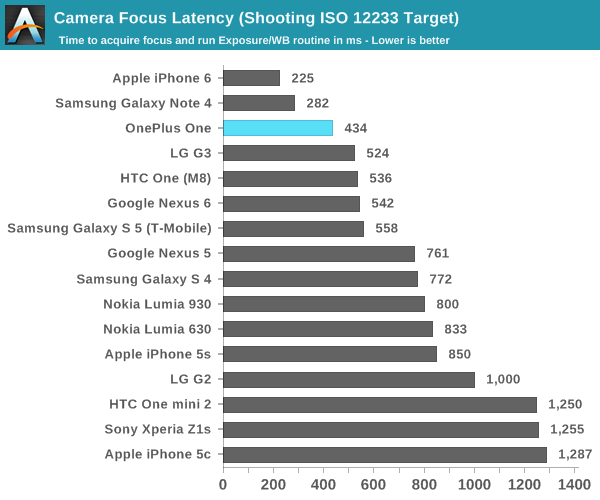
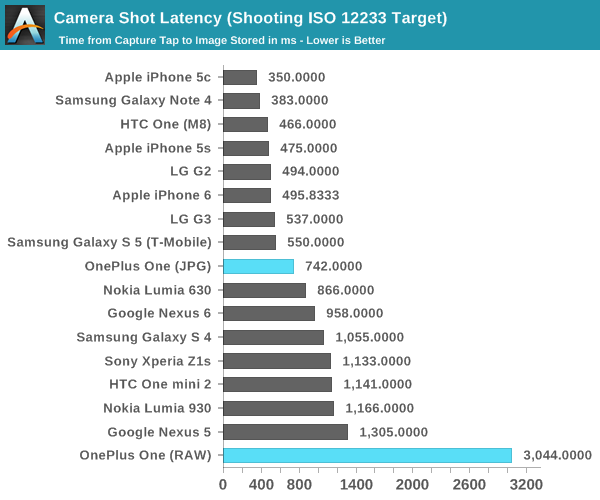
The OnePlus One does do surprisingly well in our focus test, setting a rather respectable focus latency around the same speed as the competition. On the other hand, the default capture speed is really quite long, although this is really mostly due to the RAW capture as turning off RAW capture dramatically speeds up response time in the camera to a much more respectable ~750 ms.


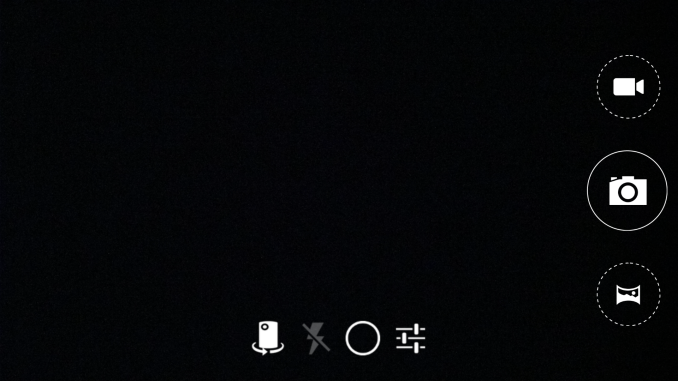

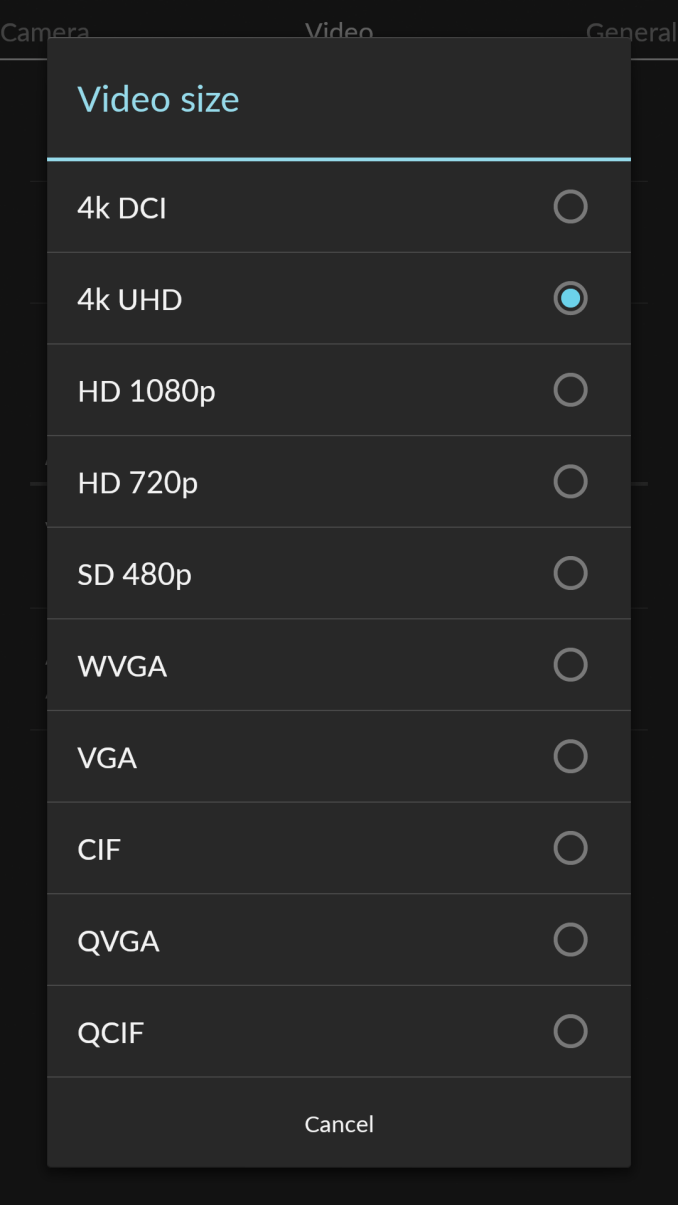


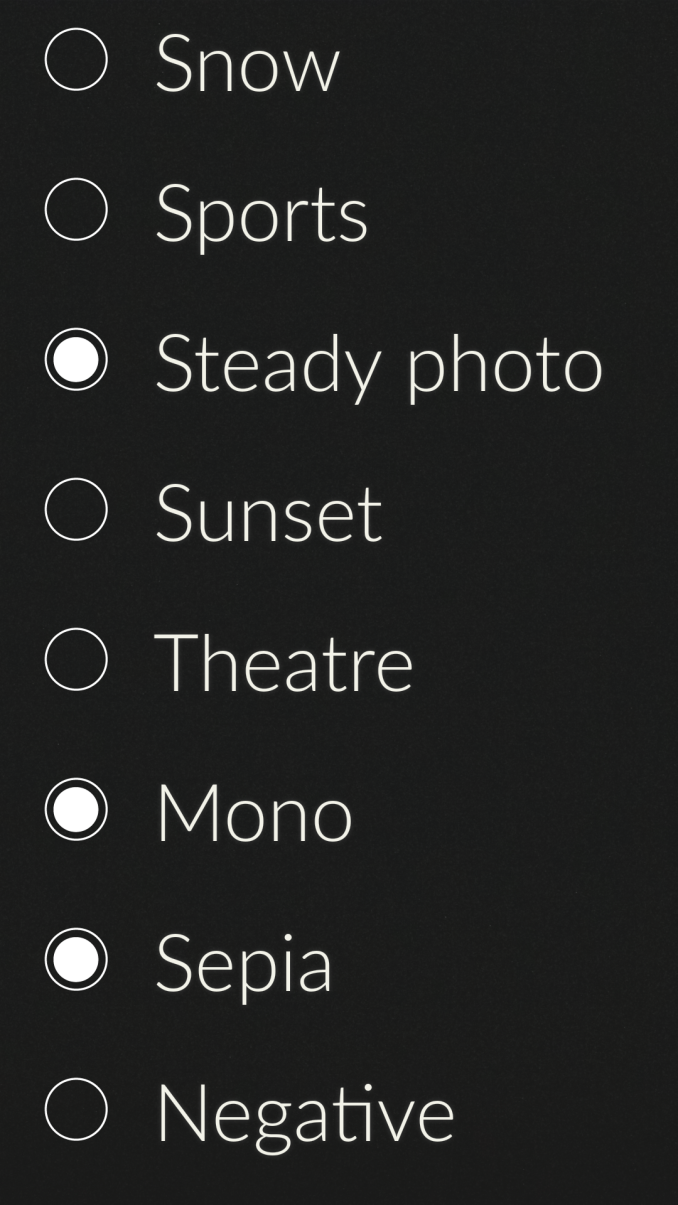
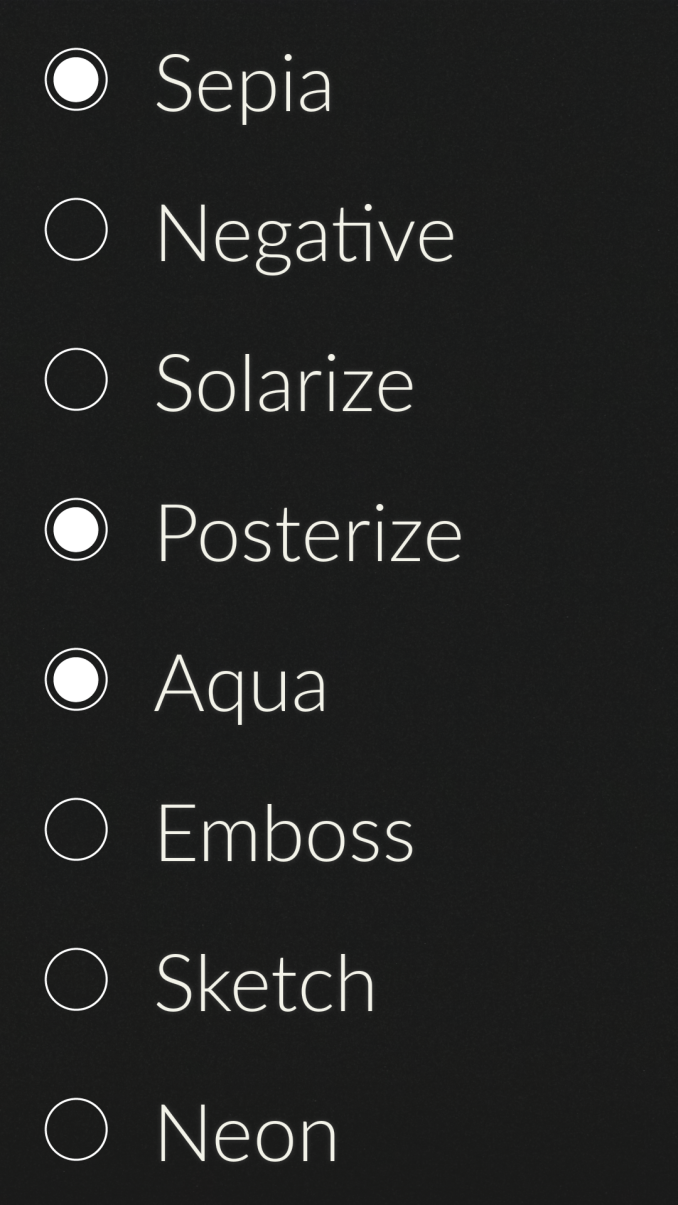
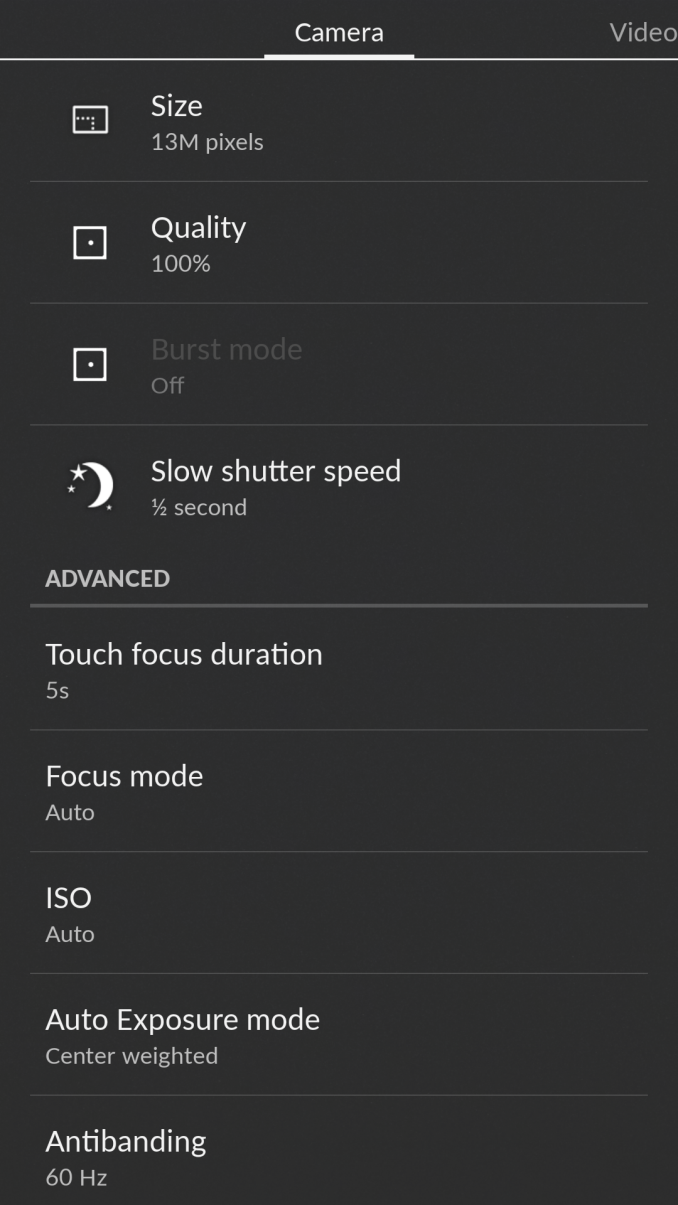









148 Comments
View All Comments
MadDuffy - Wednesday, November 19, 2014 - link
Thanks for your review.Some corrections on page one specs: MHL not supported and BT 4.0 (not 4.1).
anneoneamouse - Wednesday, November 19, 2014 - link
"Reception, at least for T-Mobile US' band 4/AWS LTE is noticeably worse than most devices that I've tried."This would seem to be a significant issue; yet this one-line detail is buried under the "misc" section, and not discussed in the conclusions at all. Three pages are devoted to analysis and discussion of photo / video quality, which for most users are likely to be secondary functions.
It's a phone; can I use it to speak clearly to a client? If not, I'll look elsewhere.
AoN.
DoktorSleepless - Wednesday, November 19, 2014 - link
Yes, this needs some serious elaboration.Cinnabuns - Wednesday, November 19, 2014 - link
I agree. Especially with all the praise and in-depth look given to the Moto X's cellular reception on this site, it would be helpful if all phones reviewed had a small section describing its reception characteristics.Harry_Wild - Thursday, November 20, 2014 - link
As a T-Mobile customer; this reception quality is top priority for picking a phone! LTE is for most data until T-Mobile changes it to Voice over Internet using LTE band. But that will be in middle 2015 and later.It not a hardware problem; it a software problem so One Plus should be able to fix it with T-Mobile's assistance.
Conficio - Friday, November 21, 2014 - link
@Harry, how come you are sure this is a software issue. Could be bad placement of the antenna or bad antenna design in general. Also, I think we don't know if the issue is limited to T-Mobile. That was just the network he tested it on.You make a good point though, if this is an LTE issue (which the article does not say), then in 2015 this phone on T-Mobile goes from good voice and bad data to issues for both.
More questions: There were software updates mentioned. Did those affect the reception issues? And did they swap out the baseband?
Conficio - Friday, November 21, 2014 - link
That also made me really nervous. I'm a T-Mobile customer and really need to know how he did notice this. I have seen some good cellular comparison tests in the past on Anandtech. Please lets get some objective comparison or at least some more detail on how this does effect the phone? Indoors, outdoors, calls dropped or not starting, get no reception where other phones have reception. Any reaction by the company?Munna2002 - Friday, November 21, 2014 - link
I am a T-Mobile customer with an OPO. My family also all use OPOs. We have no problems with LTE speeds in the NYC Metro area, although we do not have the T-Mobile Wifi calling app, which requires messing with the bootloader and kernels from what I understand.jmasterj - Wednesday, November 19, 2014 - link
This review is missing an important section that always appeared in Klug's phone reviews: network performance. There's one anecdote about how it performed on T-Mobile's LTE, but nowhere are listed even the HSPA or LTE bands supported by this device. It would be nice to see testing in this area.pjcamp - Wednesday, November 19, 2014 - link
Since you took the time to review this vaporphone, perhaps you could also do the Xperia Z3?